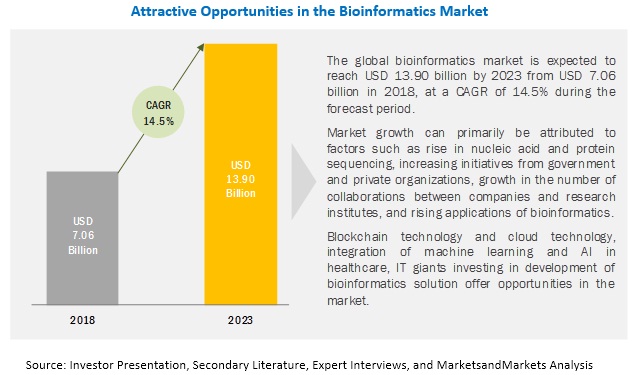What This Report Will Provide?
Bioinformatics is the application of computer technology for the management and analysis of biological data. It includes collection, storage, retrieval, manipulation, and modelling of data for analysis, visualization, or prediction through algorithms and software.
Expected Revenue Growth:
[195 Pages Report] The global bioinformatics market is expected to account for USD 7,063.7 billion in 2018. It is expected to reach USD 13,901.5 billion by 2023, at a CAGR of 14.5% during the forecast period.

Major Growth Boosters:
Growth of the bioinformatics market is driven by the growing demand for nucleic acid and protein sequencing, increasing government initiatives and funding, and increasing use of bioinformatics in drug discovery and biomarker development processes. With the introduction of upcoming technologies such as nanopore sequencing (third generation sequencing technique) and cloud computing, the market is expected to offer significant opportunities for manufacturers of bioinformatics solutions.
Download PDF Brochure: https://www.marketsandmarkets.com/pdfdownloadNew.asp?id=39
By Sector, medical biotechnology segment is expected to grow at the highest CAGR during the forecast period
Various pharmaceutical companies are increasingly adopting bioinformatics tools to decrease the cost and time involved in drug discovery. Bioinformatics approaches for target discovery and validation are proving more efficient than traditional methods. Pharma companies are also using AI along with bioinformatics tools to identify drug targets. Merck entered the AI space by collaborating with Numerate, Celgene partnered with GNS Healthcare, GSK collaborated with Exscientia, while Pfizer entered into a collaboration with IBM Watson for drug discovery research.
Bioinformatics in clinical diagnostics sector includes analysis of human genome with reference to disease diagnosis. This involves study of various omics technologies such as proteomics, metabolomics, metagenomics, epigenetics, and transcriptomics. Data generated through different omics technologies has assisted in the development of bioinformatics methodologies for clinical research and for building human databases. These computational approaches are then used to understand information about the origin, evolution, progression, and treatment of diseases, leading to the development of personalized medicine.
Key Questions Addressed in The Report:
- Who are the major market players in the bioinformatics market?
- What are the growth trends and the largest revenue-generating region for bioinformatics?
- How are bioinformatics products and services sold to customers?
- What are the major segments in bioinformatics market?
- What are the driving, restraining, opportunistic, and challenging factors for this market?
Request Sample Report: https://www.marketsandmarkets.com/requestsampleNew.asp?id=39
IT giants investing in the development of bioinformatics solutions
IT giants have started focusing on bioinformatics for healthcare applications. Investments are being made for more advanced tests and techniques in battling diseases such as cancer and Parkinson’s. Microsoft co-founder Bill Gates and Amazon founder Jeff Bezos have invested millions of dollars in Grail, a start-up by gene sequencing firm Illumina that a former Google executive leads. Grail is developing a cancer-screening blood test for people, even if they show no symptoms. The test’s development is expected to require many samples to be sequenced and analyzed by using more comprehensive bioinformatics tools and databases.
In 2018, The APAC market is expected to grow at the highest CAGR during the forecast period
The market in the Asia Pacific region is expected to offer significant opportunities for players to offset revenue losses incurred in mature markets. Emerging countries in this region are witnessing growth in their GDPs and a significant rise in disposable income levels. This has led to increased healthcare spending by a larger population base, healthcare infrastructure modernization, and rising penetration of cutting-edge research and clinical laboratory technologies, including bioinformatics, in Asia Pacific countries. These factors are expected to provide significant growth opportunities to bioinformatics companies operating in this region.

